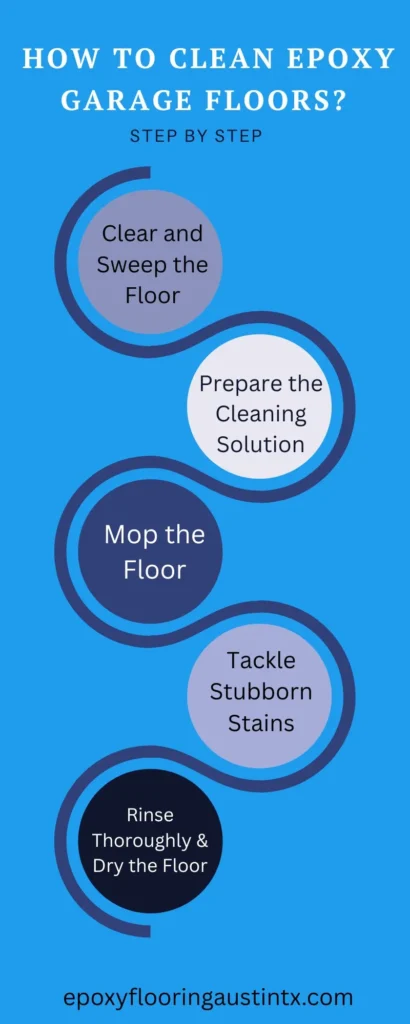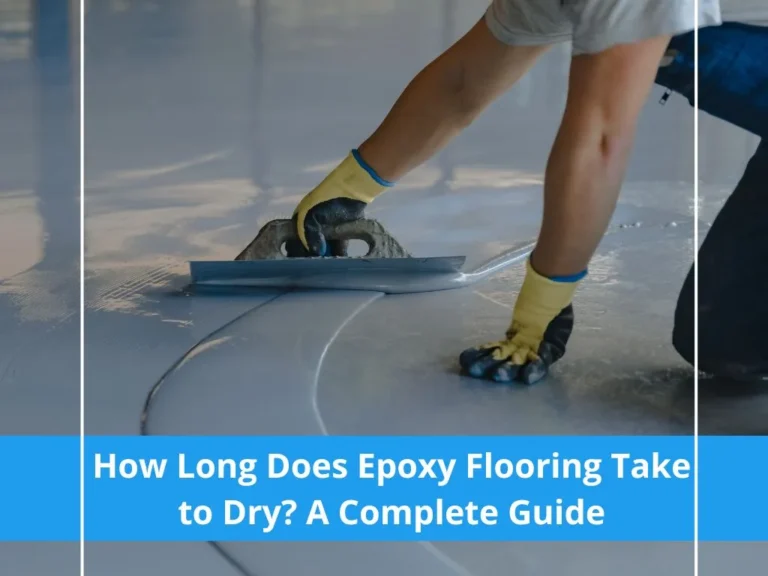How to Clean Epoxy Garage Floor? Step by Step Guide
Start by cleaning litter and loose dirt. Clean the garage epoxy floor by mopping with the solution of warm water and a mild pH-neutral cleaner. Use about 3 ounces of cleaner per gallon of water. For tough spots, let the solution sit for 1 to 2 minutes before swabbing. Rinse the floor thoroughly and you’re done.
This routine keeps your garage looking showroom-fresh without harsh chemicals or expensive equipment. The secret? Regular light cleaning beats occasional deep scrubbing every time. Let’s dive in!

Materials You’ll Need to Clean Epoxy Garage Floor
To clean your epoxy garage floor without harm, gather these basic items.
- Dust mop or soft-bristle broom
- Microfiber mop or soft sponge
- 2 buckets (1 for preparing the cleaning solution and the other for rinsing the water).
- Mild dish soap, clear ammonia, or specialized floor cleaner
- Warm water
- Squeegee or dry towel for drying
- Optional: Soft brush for tough spots
For Austin Garages: Keep extra supplies handy during cedar pollen season and after those sudden Texas thunderstorms that track mud everywhere. A good doormat at the garage entrance catches most dirt before it reaches your floor.
How to Clean Epoxy Garage Floors? Simple Steps

By following the steps, you should clean your epoxy floor within 30 minutes.
Step 1: Clear and Sweep the Floor
You should remove everything from the garage, like tools, storage bins, stairs, and vehicles etc. Then use a dust mop or soft-bristle broom to remove dirt and debris from the floor from back to front. A dust mop works great for grabbing fine particles that sweeping might miss.
Step 2: Prepare the Cleaning Solution
Mix the warm water and pH-neutral cleaner(recommended), ammonia, or mild dish soap with the proper ratio.
Proper Ratio: 3 ounces of pH-neutral cleaner per gallon of warm water or 2-3 tablespoons of mild dish soap for every gallon of warm water.
Step 3: Mop the Floor
Dip your Microfiber mop or soft sponge into the bucket of cleaning solution, wring it out well (you want damp, not soaking wet), and mop the entire floor thoroughly.
Mopping Technique:
- Work in 10-foot sections
- Use figure-eight or back-and-forth motions
- Overlap each pass slightly
- Allow the solution to sit for 1 to 2 minutes on stubborn spots before scrubbing.
Important: Never leave the cleaning solution sitting longer than a few minutes, as it can become slippery and potentially dull the finish.
Step 4: Tackle Stubborn Stains
For stubborn stains, apply the cleaner directly to the area and scrub with a soft-bristle brush.
Stain-Specific Techniques:
- Oil spots: Apply cleaner directly, let sit 1-2 minutes, scrub gently in circles
- Tire marks: Use a slightly more concentrated solution, scrub along the mark
- Dried spills: Soften with warm water first, then apply cleaner
Step 5: Rinse Thoroughly
After tackling the stains and mopping the entire floor, rinse the garage floor thoroughly with clean water to ensure that all cleaning solution is completely removed. Go over the floor at least twice with clean water.
Rinsing Methods:
- Bucket method: Use fresh, clean water and a clean mop
- Hose method: If your garage has a drain, gently rinse with a garden hose
Step 6: Dry the Floor
Use a squeegee to remove rinsed water, and then wipe any remaining moisture with a clean microfiber cloth. Allow the floor 15 to 30 minutes for complete air drying.
Dos and Don’ts of Cleaning Epoxy Garage Floor
Dos |
Don’ts |
|---|---|
The Maintenance Plan for Garage Epoxy Floor
Regular maintenance will help your epoxy garage floor last for many years. By following a simple routine, you can maintain its shine and durability. Below is an easy-to-follow maintenance schedule that will keep your epoxy floor looking like new.
Daily Maintenance
To prevent dirt buildup, dust mop or sweep high-traffic areas every day. Clean up spills immediately to avoid staining the floor, and spot clean any visible marks. In Austin’s cedar pollen season (December-February), you may need to sweep twice daily as pollen can spread quickly.
Weekly Maintenance
Each week, sweep or vacuum the entire floor, then mop with a pH-neutral cleaner. Rinse thoroughly to remove any residue. Take a few minutes to check for scratches or dull spots. This routine takes 20-30 minutes, and many homeowners choose to do it on Saturday mornings before the heat sets in.
Monthly Maintenance
Once a month, move all items and vehicles out of the garage, then vacuum the corners and edges. Mop the entire floor, focusing on trouble areas. Inspect for any damage and clean the garage door tracks. This deep cleaning should take about 45-60 minutes.
Yearly Maintenance
Perform a thorough deep clean, check for damage, and apply a new coat of sealant every 3 to 5 years if necessary. Take photos to document the floor’s condition. If you notice any damage or issues, consider calling in a professional to inspect the floor.
With just a few quick tasks each week, your epoxy floor will stay clean, protected, and looking great for years to come
Best Cleaning Agent for Epoxy Floors
The top choice is diluted clear ammonia, mix 2-5 ounces per gallon of warm water. It cuts grease without harming the finish. Other good options include mild dish soap, Windex, or eco-friendly cleaners like Simple Green. They’re safe, effective, and leave no streaks.
Cleaners You Should Not Use on Epoxy
Skip anything harsh to avoid dulling or cracking the surface. Don’t use vinegar, citrus-based products, bleach, or acidic cleaners. They break down the epoxy over time. Also, avoid soaps with salts or strong solvents.
Questions or Concerns?
If you’re in the Austin area and need professional help with your epoxy floor—whether it’s maintenance questions, resealing, or repairs—contact Epoxy Flooring Austin, TX. With over 8 years of local experience and 350+ successful installations, we understand exactly what Austin garage floors need to stay perfect.
Conclusion – How to Clean Epoxy Garage Floor?
Maintaining your epoxy garage floor doesn’t have to be a chore. With quick daily sweeps, weekly mopping using a gentle pH-neutral cleaner, and an annual deep clean, your floor will keep its glossy, professional look. Opt for safe cleaning solutions like diluted ammonia or eco-friendly options like Simple Green, and avoid damaging agents like bleach or vinegar.
For Austin residents, extra sweeping during cedar pollen season or after rainstorms helps prevent grime buildup. By following these easy steps, your garage floor will remain tough and vibrant for years. For expert help or recoating, reach out to Epoxy Flooring Austin TX!




One Comment